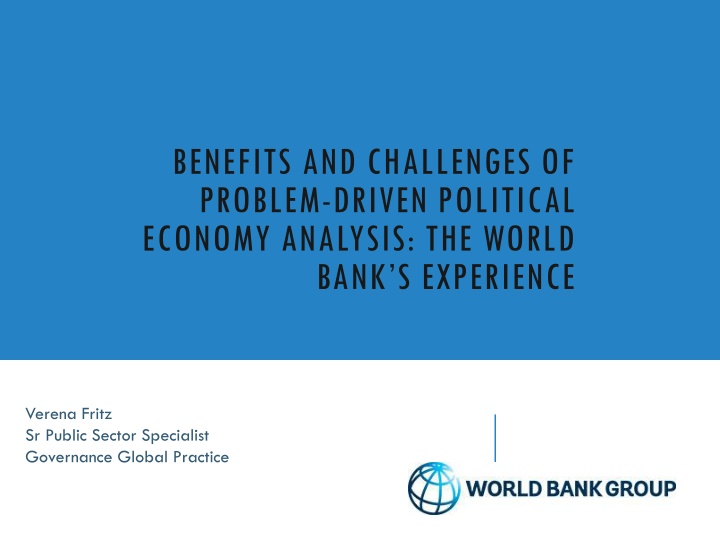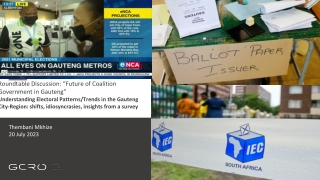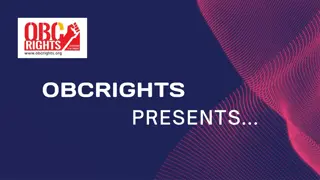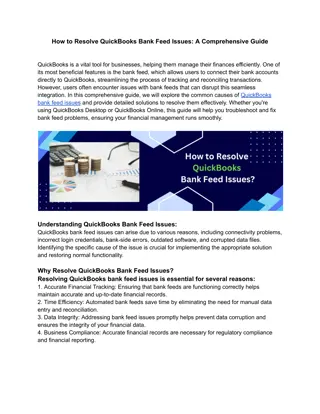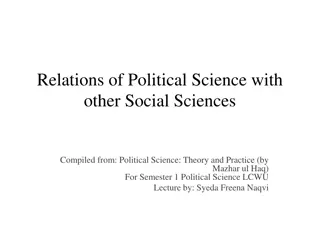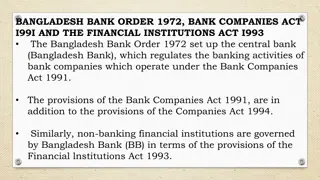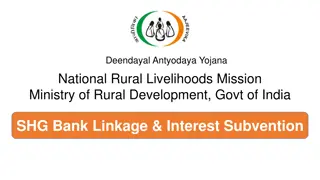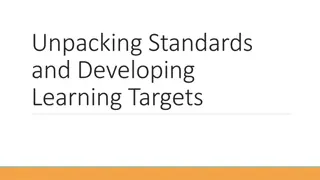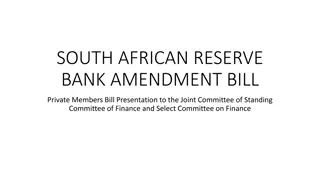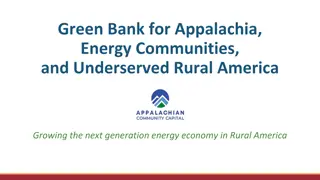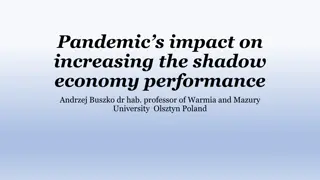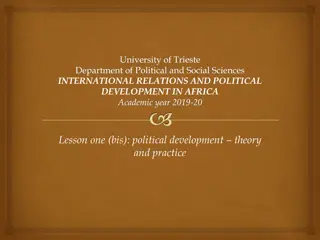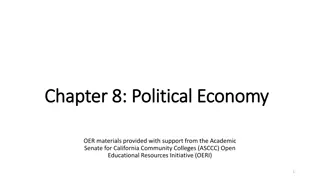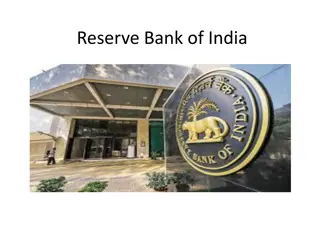Unpacking Problem-Driven Political Economy Analysis at The World Bank
Explore the benefits and challenges of problem-driven political economy analysis based on The World Bank's experience. This approach focuses on specific issues to generate actionable recommendations, aligning with the Bank's broad sectoral engagement and investment in analytic work. The problem-driven framework delves into stakeholder dynamics, feasible solutions, and implementation strategies, applicable at country, sector, or project levels.
Download Presentation

Please find below an Image/Link to download the presentation.
The content on the website is provided AS IS for your information and personal use only. It may not be sold, licensed, or shared on other websites without obtaining consent from the author.If you encounter any issues during the download, it is possible that the publisher has removed the file from their server.
You are allowed to download the files provided on this website for personal or commercial use, subject to the condition that they are used lawfully. All files are the property of their respective owners.
The content on the website is provided AS IS for your information and personal use only. It may not be sold, licensed, or shared on other websites without obtaining consent from the author.
E N D
Presentation Transcript
BENEFITS AND CHALLENGES OF PROBLEM-DRIVEN POLITICAL ECONOMY ANALYSIS: THE WORLD BANK S EXPERIENCE Verena Fritz Sr Public Sector Specialist Governance Global Practice
PROBLEM-DRIVEN PEA THE WBGS EXPERIENCE The concept of thinking about political economy challenges in a problem-driven way built on the experience of others + internal Focus the analysis on specific issues more likely to arrive at conclusions and recommendations that WBG teams can take action on Fits well with the Bank s broad engagement across a range of different sectors Window of opportunity to invest in analytic work GAC strategy (2007) Governance Partnership Fund (GPF) (2008) Problem-Driven approach published in 2009 intended as a broad tent and guideposts rather than a straightjacket
THE PROBLEM-DRIVEN FRAMEWORK IN A NUTSHELL The problem/issue for which a solution is being sought Structural drivers (e.g. global commodity prices) Institutions (formal and informal) Economic and technical analysis of feasible solutions Political economy analysis focused on: Stakeholder interests, constellations & dynamics Implications: what can best be done to make reforms happen /find a solution that delivers progress? Implementation of the identified approach Note: this framework can be used for country and sector/issue specific analysis; certain issues (e.g. PE dynamics between countries) involve additional layers
POSSIBLE LEVELS OF PE ANALYSIS Activity Regional PDPEA can be done at the regional, country, sector, or project level Easier to do good sector or project-specific PEA if country-level PEA is available Since PEA is often not published, having a good repository and response capability can be useful (i.e. if team x wants to know what PEA has been previously done in a country; or in the same sector in other countries) Undertaking PEA across countries/for regional issues such as trade integration or watershed management can be important, but also challenging Multi-country study, focused on geopolitics Macro-level country assessment focused on national dynamics Country Level Thematic analysis: (e.g., water supply, irrigated agriculture, water resource management) Sector/Theme PE to inform a specific project or component PE focused on a single policy decision Project
THE PROBLEM-DRIVEN PEA FRAMEWORK, CONTD Emphasis that PEA has to include a focus on potential positive drivers Development agencies tend to be overly optimistic Political scientists tend to be overly pessimistic about opportunities for change So: If government x seeks a loan for y, what and how can we achieve most considering technical and non-technical factors? Different frameworks have been published by various agencies but with a common/shared core These are adaptation to specific needs, based on a common core rather than different approaches For the most part, we should expect variation also in actual applications
TECHNICAL ANALYSIS AND PE PERSPECTIVES ARE COMPLEMENTARY Vulnerability/ problem constraints to growth/poverty reduction, challenges to achieve results in sectors; unsatisfactory operations Thinking Country-level GAC-PE features & situation Strategizing Problem driven governance and political economy diagnostics Technical diagnostic What can be done? (setting out options) dialogue 1. Identification of governance arrangements and underlying political economy drivers Assessment of feasibility of policy options Deciding 2. Doing Decisions, Approach to reforms, Engagement WB policy advice to government/ engagement with local stakeholders Learning did our engagement work better as the result of integrating PEA (& other DDD aspects)?
FREQUENT PE IMPLICATIONS FEASIBILITY AND ROBUSTNESS & INCREMENTAL VS TRANSFORMATIONAL ENGAGEMENT Thinking from a PE perspective: are there opportunities to make the intended reforms more feasible? .. And to make them more robust? Reform feasibility Introduction of fiscal rules if PE helps us to just get a reform passed (feasibility), but not to get it truly implemented (robustness) overall impact remains limited x x Subsidy reforms What/how significant are the trade offs with what is technically and economically optimal? Reform robustness to support change/progress e.g. smaller units/plans/steps are less likely to be captured or blocked, but how significant are the trade-offs with making progress & with efficiency? Incremental approaches adapting design given existing reform space. Transformational approaches seeking to expand reform space.
EVOLUTION OF PEA IN THE WBG CA 2009-2015 About 341 political economy analyses done across the Bank during this period About 30 with country level focus only + 15 country & sector or theme combined; the remainder sector or project focused Range of sectors: agriculture, CDD, decentralization, PFM, water & sanitation, financial sector, NRM, infrastructure, environment/forestry But still little depth in most sectors i.e. mostly one-off exercises except for some (NRM, decentralization, urban water) Regionally, Africa accounts for the bulk of the work Funding has been mixed between Trust Funds, and Bank Budget i.e. the Bank s own regular resources Harvesting lessons: Staff surveys about views on PEA mainly capturing PREM staff Impact stories on how PEA has been used to inform strategies and operations 2014 volume Problem Driven PEA The World Bank s Experience Since July 2014: Complete restructuring of the World Bank still ongoing Decrease in central funds available for any governance knowledge work Continuing engagement at the country levels and in various sectors e.g. Nigeria, water practice, etc. Continuing emphasis in many reviews, other discussions on what development is likely to work (i.e. some degree of mainstreaming ) Just beginning: dialogue to rethink the GGP s strategy for PE perspectives
TOTAL MEMBERSHIP HAS ALMOST DOUBLED IN 3 YEARS CoP Membership: 2012, 2015 The CoP has 434 members Core Group Extended Group The CoP has grown by 49% since 2012 381 244 53 46 2012 2015 Other 9% Human Development 8% Corporate and Operations 8% Membership is diverse across WBG s practices and has become more diverse over time Sustainable Development 19% Regional 11% Not Reported 0% Governance & Economic Management 45%
EXAMPLES OF COUNTRY APPLICATIONS
FEASIBLE 2ND/NTH BEST OPTIONS Strengthen information of citizens on costs and benefits of the current subsidy regime MOROCCO Consider innovative social programs alongside subsidy reductions Narrow reforms to what is compatible with interests of influential stakeholders Engage service users around the benefits of changes ZAM Engage (opting out) middle class, including for enhanced monitoring of government expenditures DOMINICAN REPUBLIC Prioritize professionalization in power utilities over price reforms Strengthen local accountability SIERRA LEONE Re-direct resources to sub-national gov ts given greater chance of accountability due to less ethnically aligned voting
COLLECTIVE ACTION/MULTISTAKEHOLDER Engage on policy options preferred by local stakeholders even if against best practice MNG Build capacity for mining sector policy analysis among n0n governmental stakeholders (including think tanks) Engage (opting out) middle class, including for enhanced monitoring of government expenditures Prioritize professionalization in power utilities over price reforms DR GHA Enhance mutual confidence around rules of the game and potential win- win benefits from investments in commercial agriculture including support for farmers associations Provide user-friendly information on local infrastructure allocation decisions, and service delivery performance and link allocations to performance Target grants directly to wards rather than to districts PNG Target allocations based on precise criteria PH
KEY LESSONS: WHAT DOES IT TAKE FOR PEA TO AFFECT DEVELOPMENT ENGAGEMENT AND RESULTS? It must meet the benchmark of quality It must be known by those who are expected to change approaches (e.g. sector colleagues) The resulting recommendations must be sufficiently practical and granular to act upon Tailored to the engagement Management endorsement and encouragement & resources from both the country and the sector side CMU: we want to engage this way with the client Sector/practice: we want to try (and monitor) whether this 2-nd best/unorthodox approach works in this type of situation Why might management care? The jiu-jitsu benefit: Channeling political energy towards development compatible action (and away from actions that damage shared prosperity) Helping to leverage limited resources to maximize development impact of development funds allocated
KEY LESSONS: OPPORTUNITIES Opportunity often rests in the fact that politicians would like to achieve something Showing roads built, power blackouts reduced, MDGs achieved, etc. Show off to citizens, to potential challengers, to other presidents but often struggle with how to achieve these goals A related set of opportunities is that citizens are increasingly better informed and expect more People see through ribbon cutting behavior Expect at least basic levels of service delivery even if this is far from a panacea Still, it also happens that citizens vote for politicians who are known to be corrupt & vote buying Citizens have parochial interests in what benefits them directly Particularly challenging to build sufficient information/understanding and trust in the benefits of shifts in macro-policies and sector policies that have immediate strong negative impacts (subsidy removal, power tariffs)
USING POLITICAL ECONOMY AND ASSOCIATED PERSPECTIVES IN A STRATEGIC WAY Are we truly capable of recognizing and reacting to opportunities? do we recognize and react to (potentially) transformative governments Georgia in 2004; Edo state (Nigeria) in 2008; Tanzania and Nigeria in 2015? Are we sufficiently capable of rapid and relevant support? How best to connect PEA and other innovative approaches impact evaluations, DDD, and others This may not need perfect templates, but some greater clarity will be helpful Can we take a sufficiently systematic approach to test whether the proposed approaches do deliver better development results (relative to more standard operating models)? PEA plus/Doing development differently from analysis to decisions, to implementation to learning whether this worked takes at least 5 years very few development partners are truly able to conduct a coherent experiment over such an extended period of time Overall important not to over-innovate /detach innovation from implementation Policy debates have moved faster than implementation Temptation to move on to the next interesting thing before wider scale implementation has happened But there has also been some staying power PEA has now gradually moved into development practice for over a decade (since late 1990s/early 2000s)
